 An innovative ‘surgical patch’ that promotes rapid regrowth of tendon tissue could transform the success of shoulder repair operations.
An innovative ‘surgical patch’ that promotes rapid regrowth of tendon tissue could transform the success of shoulder repair operations.
The patch will be used by surgeons to repair torn tendon tissue, and patient trials are expected to begin this year.
Made from a new material developed by a team of surgeons, engineers and biochemists in Oxford, the ‘smart patch’ promotes rapid regrowth of damaged tissue ensuring the injury heals more quickly and more successfully.
The project is a collaboration between the University of Oxford and Oxford University Hospitals NHS Trust, and is funded by the National Institute for Health Research (NIHR) Oxford Biomedical Research Unit and the Medical Research Council.
Andy Carr, an Oxford University Hospitals surgeon and Nuffield Professor of Orthopaedic Surgery at the University of Oxford, led the development of the patch. It has been designed to repair damage to the rotator cuff, the group of tendons and muscles that controls movement of the shoulder.
More than 10,000 rotator cuff repairs are performed in the UK each year (more than 300,000 are performed in the US), and the group’s own research has shown that between 25% and 50% will fail to heal properly.
‘Around a third of the population will suffer from shoulder pain due to tendon disease at some time in their life, making it the third most common musculoskeletal complaint,’ said Professor Carr of the Nuffield Department of Orthopaedics, Rheumatology and Musculoskeletal Sciences at Oxford University.
‘This type of injury will not kill you but it can seriously affect your quality of life. Patients are often in a lot of pain, with severely restricted movement. In some cases it can affect your livelihood and in older people it can affect independence. This will become more and more of a problem as the population ages and the retirement age is increased.’
Professor Carr said the failure rate of surgery was due to the fact that the body was failing to repair properly after surgery. To improve the outcomes of surgery, the team have designed a material that mimics the normal environment that cells require in order to mount a successful repair.
He added: ‘The key to the new patch is creating a composite of two material layers. One layer is a very fine “nanoscale” synthetic mesh that is recognised by cells and which promotes growth of new tissue. Our patch provides the physical cues needed for normal growth and development.
‘However, because this fine mesh is relatively flimsy, a second woven layer of thicker strands is bonded to it to provide strength. This stronger layer means the scaffold can be sutured in position by a surgeon. It also protects the repair during the six to eight weeks required for tissue healing.’

An additional and important feature is that the scaffold degrades and is absorbed by the body after three to six months, leavin
g no foreign material in the long term.
With an expected price tag of less that £1,500, the new patch could offer effective treatment at a fraction of the cost of alternatives such as the use of stem cells or growth factors. Given the increasing number of operations being carried out, this will be a significant consideration.
Professor Carr said: ‘One of the great strengths here in Oxford is having clinicians, engineers, biochemists and other specialists working together across the partnership between the University of Oxford and Oxford University Hospitals NHS Trust. This multidisciplinary approach means that when unsolved clinical problems are identified we can investigate the cause, then develop a solution, before returning to clinic to test if it helps patients. It’s a bedside to bench and back again journey.’
Patient trials of the new patch are set to begin next year. Professor Carr added: ‘If successful, the patch has the potential to be adapted for use in other tissue repair operations such as heart surgery, hernia repair, bladder repair and the treatment of early arthritis.’
Source: University of Oxford












 An innovative ‘surgical patch’ that promotes rapid regrowth of tendon tissue could transform the success of shoulder repair operations.
An innovative ‘surgical patch’ that promotes rapid regrowth of tendon tissue could transform the success of shoulder repair operations.